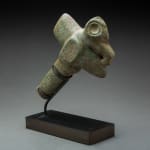Taino Ceremonial Axe-Head, 1200 CE - 1500 CE
Greenstone
25.2 x 18.5 x 6 cm
9 7/8 x 7 1/4 x 2 3/8 in
9 7/8 x 7 1/4 x 2 3/8 in
BF.038
Further images
Taino stone axes served as both tools and weapons, but richly carved examples such as this one were designed for ceremonial purposes. Fashioned from a dark, flecked green stone, the...
Taino stone axes served as both tools and weapons, but richly carved examples such as this one were designed for ceremonial purposes. Fashioned from a dark, flecked green stone, the surface has been highly polished to create a wonderfully smooth finish. The identity of the head is ambiguous, but it may well represent a bird, possibly a parrot. The deeply carved circular eyes and the beak-like nose recall Costa Rican avian sculptures. Two panels of lightly incised geometric designs adorn the sides of the axe blade. The combination of avian and anthropomorphic features in a single image was common in Taino art and relates to their mythological traditions. Birds were highly esteemed for both religious and economic reasons. The Taino cosmos was divided into three sections: subterranean waters, land and sky. Animals that were able to move through two or more of these spheres were highly esteemed and credited with magical powers. Coloured feathers were also used for ceremonial dress and widely traded.
The Spanish chroniclers who arrived in the Caribbean in the late fifteenth century recorded over forty Taino names for birds. Exotic parrots were also among the first items sent as tribute to King Ferdinand of Spain. A sculpture of this quality and complexity would undoubtedly have belonged to one of the Taino chieftains (caciques), who commissioned elaborate stone sculptures to bolster their religious and political authority. It would have been attached to a wooden shaft which has since perished. This is an incredibly rare item, which continues to impress us with its bold, abstract design. (AM)
The Spanish chroniclers who arrived in the Caribbean in the late fifteenth century recorded over forty Taino names for birds. Exotic parrots were also among the first items sent as tribute to King Ferdinand of Spain. A sculpture of this quality and complexity would undoubtedly have belonged to one of the Taino chieftains (caciques), who commissioned elaborate stone sculptures to bolster their religious and political authority. It would have been attached to a wooden shaft which has since perished. This is an incredibly rare item, which continues to impress us with its bold, abstract design. (AM)





